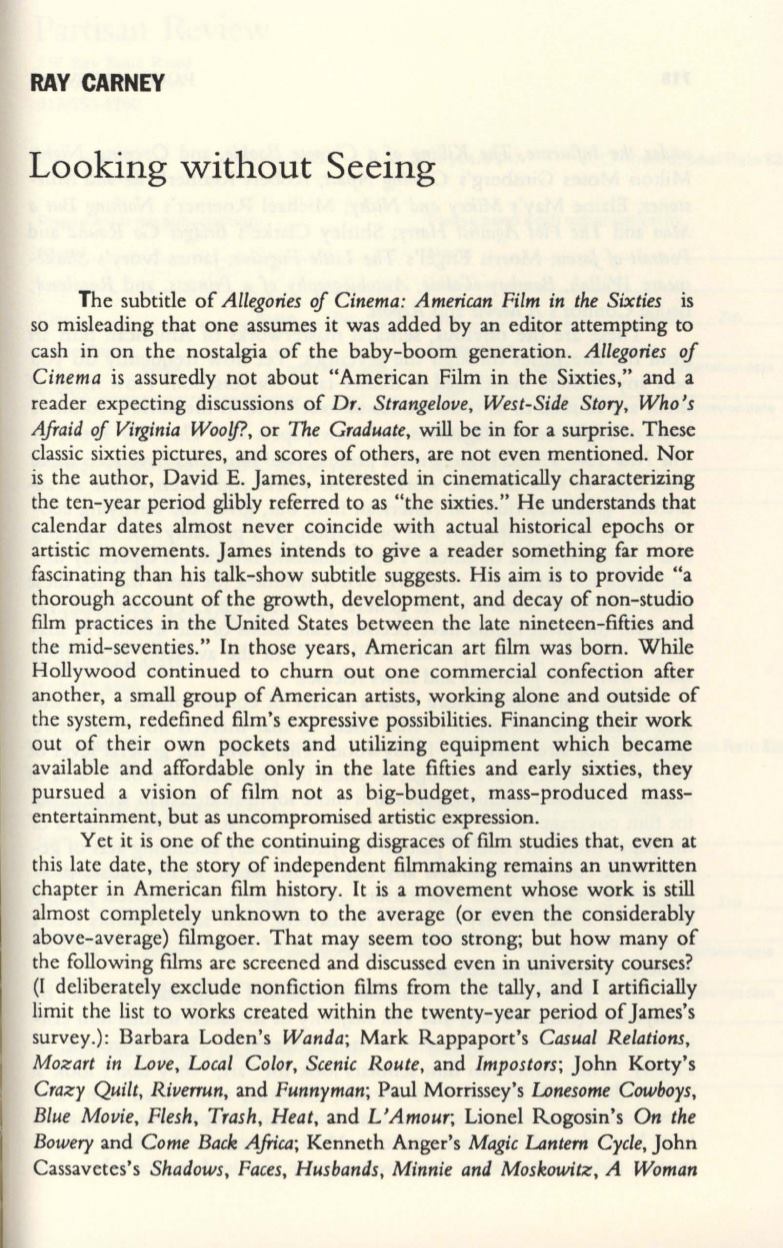
RAY CARNEY
Looking without Seeing
The subtitle of
Allegories
of
Cinema: American Film in the Sixties
is
so misleading that one assumes it was added by an editor attempting to
cash in on the nostalgia of the baby-boom generation.
Allegories of
Cinema
is assuredly not about "American Film in the Sixties," and a
reader expecting discussions of
Dr. Strangelove, West-Side Story, Who's
Afraid of Virginia Woo!/?,
or The
Graduate,
will be in for a surprise. These
classic sixties pictures, and scores of others, are not even mentioned. Nor
is the author, David E. James, interested in cinematically characterizing
the ten-year period glibly referred to as "the sixties." He understands that
calendar dates almost never coincide with actual historical epochs or
artistic movements. James intends to give a reader something far more
fascinating than his talk-show subtitle suggests. His aim is to provide "a
thorough account of the growth, development, and decay of non-studio
film practices in the United States between the late nineteen-fifties and
the mid-seventies." In those years, American art film was born. While
Hollywood continued to churn out one commercial confection after
another, a small group of American artists, working alone and outside of
the system, redefined film's expressive possibilities. Financing their work
out of their own pockets and utilizing equipment which became
available and affordable only in the late fifties and early sixties, they
pursued a vision of film not as big-budget, mass-produced mass–
entertainment, but as uncompromised artistic expression.
Yet it is one of the continuing disgraces of
film
studies that, even at
this late date, the story of independent filmmaking remains an unwritten
chapter in American fUm history. It is a movement whose work is still
almost completely unknown to the average (or even the considerably
above-average) fUmgoer. That may seem too strong; but how many of
the following films are screened and discussed even in university courses?
(I deliberately exclude nonfiction films from the tally, and I artificially
limit the list to works created within the twenty-year period ofJames's
survey.): Barbara Loden's
Wanda;
Mark Rappaport's
Casual Relations,
Mozart in Love, Local Color, Scenic Route,
and
Impostors;
John Korty's
Crazy Quilt, Riverrun,
and
Funnyman;
Paul Morrissey's
Lonesome Cowboys,
Blue Movie, Flesh, Trash, Heat,
and
L'Amour;
Lionel Rogosin's
On the
Bowery
and
Come Back Aftica;
Kenneth Anger's
Magic Lantern Cycle,
John
Cassavetes's
Shadows, Faces, Husbands, Minnie and Moskowitz, A Woman


